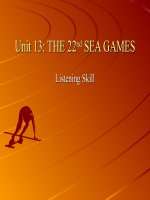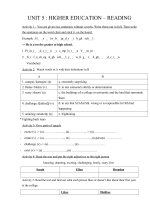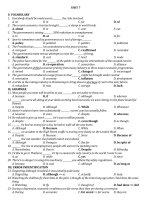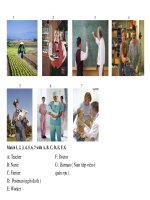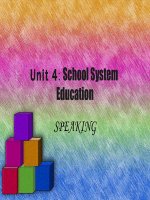Unit 4 English 12 Reading
Bạn đang xem bản rút gọn của tài liệu. Xem và tải ngay bản đầy đủ của tài liệu tại đây (859.6 KB, 16 trang )
<span class='text_page_counter'>(1)</span>
<span class='text_page_counter'>(2)</span> Unit 4:. Lesson: A. Reading - P22.
<span class='text_page_counter'>(3)</span> I. Pre- reading Facts about schools in Vietnam 1. Children start Grade 1 when they are 6 years old. 2. Schooling is compulsory from the age of 6 to 16. 3. The School year generally begins in September and ends in late May. 4. The students do not have any examinations when they finish secondary school. 5. A school year consists of two terms..
<span class='text_page_counter'>(4)</span> II. While you read:. UNIT 4 : A.. Reading. họcyear . academic year (n) : Năm School. . parallel (adj). : Song song. . core subject (n). : Main subject : Môn học chính. . certificate (n). : Giấy chứng nhận. . curriculum (n). : Chương trình giảng dạy. . state school (n). : Trường công lập # public school.
<span class='text_page_counter'>(5)</span> II. While you read: Read passage then doin the thatpassage follow. which Task the 1. Find wordsand or phrases thetasks reading have the following meanings.. 1. Schools in which all children can attend without paying tuition fees state schools ( para : 2 – line 1,2 ). 2. A stage of study for children aged from 5 to 10 primary education ( table ) 3. A stage of study for children aged from 11 to 16 secondary education ( table ) 4. Put into force by the law compulsory (para1 ,sent 1) 5. The examinations children sit at the end of compulsory education the General Certificate of Secondary Education (GCSE)( table ) 6. A detailed plan for a course of study offered in a school or college curriculum ( para 4 ).
<span class='text_page_counter'>(6)</span> II. While-reading:. UNIT 4 : A. Reading. Task 2. Read the passage again and answer the questions..
<span class='text_page_counter'>(7)</span> Schooling is compulsory for all English children from the age of 5 to 16. The academic year in England runs from September to July and divided into three terms. Autumn term is from the beginning of September to mid-December. Spring term is from the beginning January to mid-march and Summer Term from early April to mid-July. Each term is separated by a one-week break called half term, usually at the end of October, mid-February and the end of May. There are two parallel school system in England. The first is the state school system,1.which is free all Studentsinand paid by thestart state. their The second When doforchildren England category is the ‘independent’ or ‘public’ school system, which is fee-paying. education at of school? The state compulsory school system, which educate 93% the pupils in England, can be divided into two levels of education: Primary education and secondary education. See the table below for more information about the school education system in England. The National Curriculum is set by the government and must be followed in all state schools. It is made up of the following subjects: English, Design & Technology, Geography, Maths, Information Technology, Music, Science, Arts, Physical Education, History, and a Modern Foreign Language. English, Maths and Science are core subjects, which are compulsory in the national examinations at certain stages of the school education system.. From the age of 5..
<span class='text_page_counter'>(8)</span> Schooling is compulsory for all English children from the age of 5 to 16. The academic year in England runs from September to July and divided into three terms. Autumn term is from the beginning of September to mid-December. Spring term is from the beginning January to mid-march and Summer Term from early April to mid-July. Each term is separated by a one-week break called half term, usually at the end of October, mid-February and the end of May. 2. How many terms are there in a school There are two parallel school system in England. The first is the state school England? system,year which in is free for all Students and paid by the state. The second category is-the ‘independent’ or ‘public’ school system, which is fee-paying. 3 terms. The state school system, which educate 93% of the pupils in England, can be divided into two levels of education: Primary education and secondary education. See the table below for more information about the school education system in England. The National Curriculum is set by the government and must be followed in all state schools. It is made up of the following subjects: English, Design & Technology, Geography, Maths, Information Technology, Music, Science, Arts, Physical Education, History, and a Modern Foreign Language. English, Maths and Science are core subjects, which are compulsory in the national examinations at certain stages of the school education system..
<span class='text_page_counter'>(9)</span> Schooling is compulsory for all English children from the age of 5 to 16. The academic year in England runs from September to July and divided into three terms. Autumn term is from the beginning of September to mid-December. Spring term is from the beginning January to mid-march and Summer Term from early April to mid-July. Each term is separated by a one-week break called half term, usually at the end of October, mid-February and the end of May. There are two parallel school system in England. The first is the state school system, which is free for all Students and paid by the state. The second category is the ‘independent’ or ‘public’ school system, which is fee-paying. The state school system, which educate 93% of the pupils in England, can be divided into two levels of education: Primary education and secondary education. See the table below for more information about the school education system in England. 3. What are the two school systems in England? The National Curriculum is set by the government and must be followed in all - The state school and the “independent” or state schools. It is made up of the following subjects: English, Design & “public” schoolMaths, systems. Technology, Geography, Information Technology, Music, Science, Arts, Physical Education, History, and a Modern Foreign Language. English, Maths and Science are core subjects, which are compulsory in the national examinations at certain stages of the school education system..
<span class='text_page_counter'>(10)</span> Schooling is compulsory for all English children from the age of 5 to 16. The academic year in England runs from September to July and divided into three terms. Autumn term is from the beginning of September to mid-December. Spring term is from the beginning January to mid-march and Summer Term from early April to mid-July. Each term is separated by a one-week break called half term, usually at the end of October, mid-February and the end of May. There are two parallel school system in England. The first is the state school system, which is free for all Students and paid by the state. The second category is the ‘independent’ or ‘public’ school system, which is fee-paying. The state school system, which educate 93% of the pupils in England, can be divided into two levels of education: Primary education and secondary education. See the table below for more information about the school education system in England. The National Curriculum is set by the government and must be followed in all state schools. It is made up of the following subjects: English, Design & Technology, Geography, Maths, Information Technology, Music, Science, Arts, Physical Education, History, and a Modern Foreign Language. English, Maths and Science are core subjects, which are compulsory in the national examinations at certain stages of the school education system.. 4. Do children have to pay fees if they go to “independent” or “public” schools? - Yes..
<span class='text_page_counter'>(11)</span> Schooling is compulsory for all English children from the age of 5 to 16. The academic year in England runs from September to July and divided into three terms. Autumn term is from the beginning of September to mid-December. Spring term is from the beginning January to mid-march and Summer Term from early April to mid-July. Each term is separated by a one-week break called half term, usually at the end of October, mid-February and the end of May. There are two parallel school system in England. The first is the state school system, which is free for all Students and paid by the state. The second category is the ‘independent’ or ‘public’ school system, which is fee-paying. The state school system, which educate 93% of the pupils in England, can be 5. How many core subjects areeducation there in divided into two levels of education: Primary andthe secondary education. national curriculum? See the table below for more information about the school education system in - 3 core subjects (English, Maths and Science). England. The National Curriculum is set by the government and must be followed in all state schools. It is made up of the following subjects: English, Design & Technology, Geography, Maths, Information Technology, Music, Science, Arts, Physical Education, History, and a Modern Foreign Language. English, Maths and Science are core subjects, which are compulsory in the national examinations at certain stages of the school education system..
<span class='text_page_counter'>(12)</span> Level of education. Grade/ Year (from – to). Age (from – to). 6. When can students take the examination? childcare 3 –GCSE 4 - Whenenvironment they finish the secondary school. Pre-school. Primary education. in an Infant or Primary school. 4- 5. 1–3 4-6. 5–7 8 - 10. 7-9 Secondary education. 10 - 11. 11 – 14 14 – 16 (end of General Certificate compulsory of Secondary education) Education (GCSE).
<span class='text_page_counter'>(13)</span> III. Post-reading. UNIT 4: A. Reading. Remember the main content of the passage and fill in the diagram with correct information taken from the reading text..
<span class='text_page_counter'>(14)</span> ENGLAND SCHOOLING Academic ---(1)--- year year Autumn ---(2)--- term term. ---(3)--Spring term term. ---(5)--State school school (93% (93%of of the the students) students). Primary school ---(7)---. Summer ---(4)--- term term. ---(6)--Public school school (fee paying). Secondary school ---(8)--- school. GCSE GCE”A” Level. University.
<span class='text_page_counter'>(15)</span> Homework 1. Learnt new words by heart. 2. Prepare for the next lesson – Unit 4: Lesson 2: B. Speaking 3. Write a passage (about 100 words) about the subject you like studying most. •The name of the subject. • Why you like it. • How you study it. • How much time you use for it..
<span class='text_page_counter'>(16)</span>
<span class='text_page_counter'>(17)</span>



